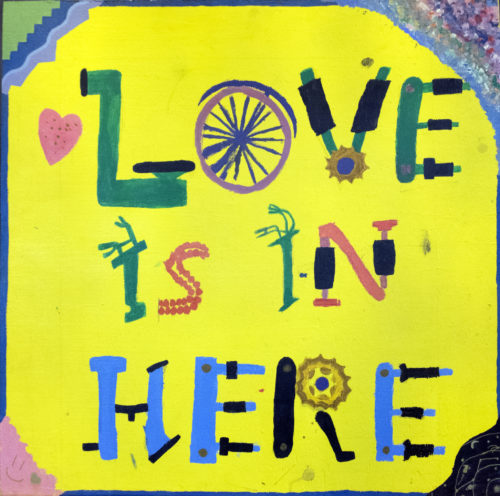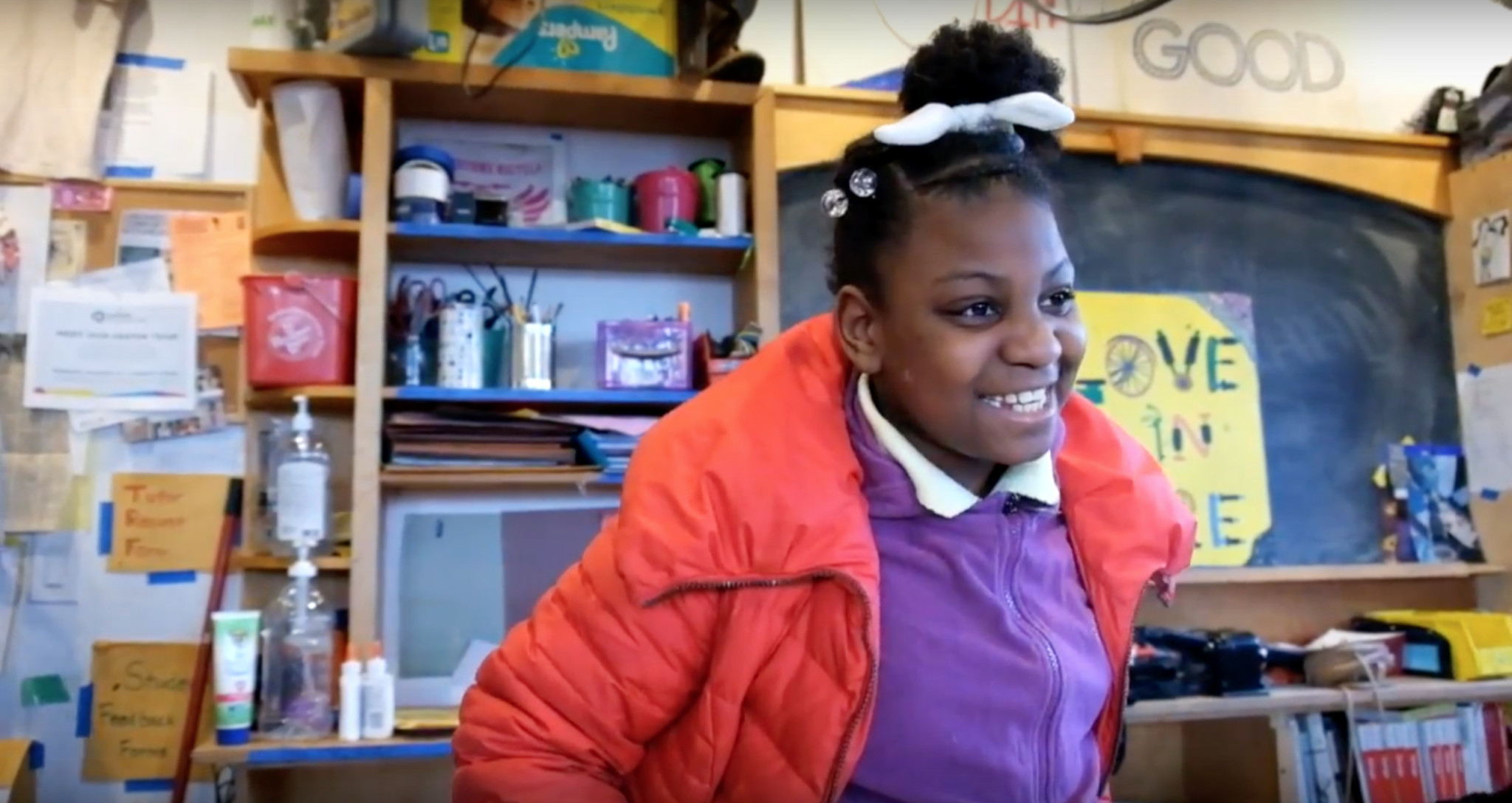On Fridays after school, seventh-grade student Imani Lamb takes the short walk from Andrew Carnegie Elementary School to Blackstone Bicycle Works (BBW), located in the Experimental Station. She meets up with friends, snacks on the provided fresh fruit, and heads upstairs to the classroom overlooking the community bike shop. It’s time for the Friday art workshop, and program leader Tita Thomas has a project for her students: design your dream bicycle helmet.
“On my bicycle helmet, it says ‘Ways to Say Beautiful.’ I think that everyone and everybody is beautiful, so I wrote the ways to say beautiful in every single language to let you know that everybody is beautiful,” Lamb said.
According to a mission statement hanging in BBW’s main room, it’s a “full-service bike shop dedicated to promoting ecological practices and empowering youth—teaching mechanical skills, job skills, and business literacy to boys and girls ages 8-18.” Students even swing by the local hub to play basketball and borrow bikes for short rides too.
As a revolutionary bike shop, BBW is an integral part of the variety of educational and cultural programs hosted by the Experimental Station in Woodlawn. In October 2016, community-taught visual artist and cultural organizer Tita Thomas, who formerly volunteered at the shop, began hosting a Friday afternoon art program in conjunction with the University of Chicago’s South Side in Focus, a nonprofit that supports artists, small businesses, and individuals across the South Side through community art projects. Born and bred on the South Side, Thomas uses art as a tool for self-healing and as a form of cultural resistance and community liberation, according to her artist biography.
Simultaneously furthering and spotlighting the shop’s larger mission, “Art with Tita Thomas” aims to empower youth, teach students about forms and materials that can be used to document and promote the life of the shop, support practical needs like creating signage and instructional materials, and use bicycles and bike culture as a point of departure for exploring broader concepts. Youths that attend the weekend programs over the summer hail from across the 60637, 60617, and 60619 zip codes, according to Experimental Station Assistant Director Matthew Searle. Most academic-year participants, like Imani Lamb, attend Carnegie Elementary.
In order to create her helmet, Lamb googled translations of “beautiful” in more than a dozen languages with help from South Side in Focus volunteers. Across the table—scattered with crayons, markers, and colored pencils—the Slack sisters were designing their own rainbow-themed helmets.
“I love making rainbows. The thing that I do when I’m bored—all I do is just get a notebook and some crayons and make a rainbow,” said Eliyah Slack, a fifth-grade student at Andrew Carnegie Elementary.
EliJournee Slack, a third-grade student at Carnegie, echoed Eliyah’s thoughts: “When it’s fire like at the bottom of a rocket ship—I did that but it’s a rainbow. I wanted to make the helmet pretty and so everyone can wear it. Rainbows aren’t just for girls. I like art because when you draw stuff, it’s not just for certain people. Sometimes it’s for everybody.”
Last spring, the artists hosted a gallery opening on the ground floor of the Experimental Station. The event featured a large dome made of tires, drinks from Build Coffee, and twelve colorfully painted square panels, each inspired by conversations that Thomas had with her students.
“We were working on a sign for the bike shop for the future,” Eliyah Slack said. “Tita asked us questions about how it would look in the future, and we have different signs for it.”
“Today was designing your own bicycle helmet, last year was envisioning the future of Blackstone and how we shape communities to fit that future,” said program volunteer Gabe Barrón. “A big theme of this whole year is: how do we cultivate community? Tita brings in lots of elements of Afrofuturism, which I think is incredible inspiration for the kids and volunteers like myself.”

The bright panels display phrases such as “Every wheel gets greased,” “We got bars,” and “Love is in here.”
“In the past, we did a project called ‘Every wheel gets greased.’ We painted a picture, and I worked on that with everybody else,” Lamb said.
One panel, a portrait of shop ancestor Tommie L. Hollins donning a helmet, currently hangs beside the shop door. This particular panel was a main feature of the inaugural art show, which also highlighted Hollins’s bike, drawings, and hand-made flowers.
“He was the elder of the shop and was often the first introduction to the shop. Actually, Tommie was the first person that I interacted with when I first came to the shop. He greeted me at the gate right there. So he’s a large part of what people think of when they think of Blackstone Bicycle Works,” Thomas said, adding, “He became an ancestor the same year that I started the program, so it was really important for me to acknowledge the past and the impact that the past has made in this program.”
Many others, following in Hollins’s footsteps, have left lasting impressions on the program. Thomas reflected on the making of the “Love is in here” panel, which she found particularly memorable.
“That entire process was so beautiful because it was the most collaborative project I’ve ever seen. Literally every person in the bicycle shop put their hands on a paintbrush, contributed to the design, helped hang it—helped in some kind of way to make it possible. I feel like ‘Love is in here’ really captures everything I have experienced here at the bike shop. Gabe’s mom was even part of it. I love telling people that because that really emphasizes how much of a community collaboration it was—from the young people, to the staff, to our volunteers’ families,” Thomas said.
In the past, the youths have also created zines and collaborated with a professional photographer. Now, they have big plans for this year’s upcoming spring exhibition. In addition to their weekly projects, the students are painting a group banner, creating a new zine that draws on student drawings and project documentation, and constructing a cardboard model of the bike shop, planned in collaboration with artist Dorian Sylvain at the Hyde Park Art Center.
Some students even plan to pursue art long-term.
“I just want to be an artist. I want to paint, draw, and a lot of other stuff. I might do posters about how people in the past helped stop slavery. I want to put them in schools, in history museums, and also places where kids and grown-ups can see about people that were slaves in the past and helped free slaves,” EliJournee Slack said.
“I like that you’re able to just go on your creative side and be able to just express yourself,” said Carnegie fifth-grader Laila Kersh.
“I think art is really cool, and I think it’s a really big way to express yourself and how you feel about everything!” said Carnegie sixth-grader Crysten Epting, adding, “I think art is not something that people just do. I think art is something that people dream about or think about. I think that art should be involved with people’s everyday life.”
The opening reception of the second annual “Bike Shop Art Show” will take place on Wednesday, May 23rd, 5pm–8 pm
Support community journalism by donating to South Side Weekly

